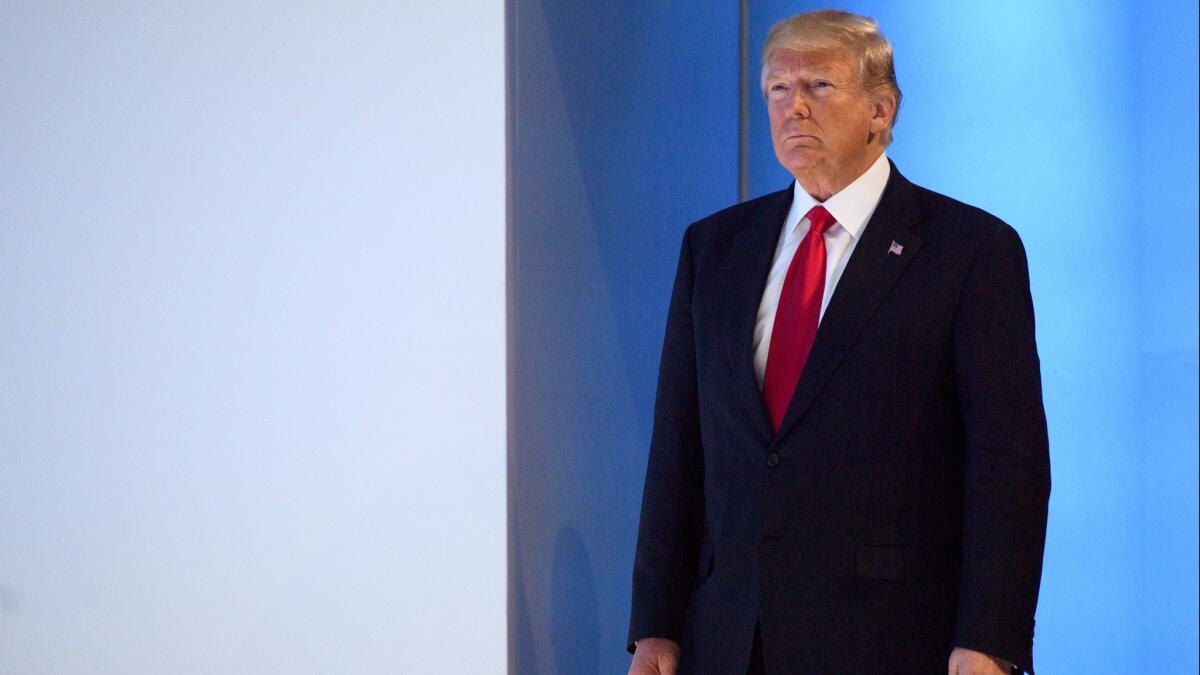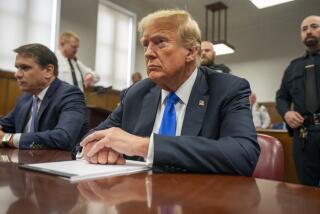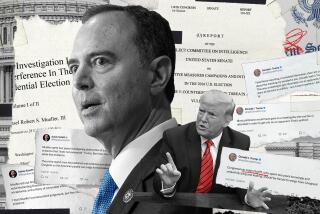Analysis:: Trump’s own actions put him at risk for obstruction — if not legally then politically

Reporting from Washington — At least half a dozen times, President Trump by his actions has invited scrutiny for possible obstruction of justice in the Russia probe, and now comes a report that last year he ordered the firing of the very man investigating him.
That man, special counsel Robert S. Mueller III, ultimately will decide whether the president’s words and deeds make a case for a criminal indictment or an impeachment referral to Congress.
For now, however, Trump has increased his political jeopardy, giving new arguments to impeachment advocates. That seems likely to raise the stakes for this year’s midterm election, in which control of Congress will be up for grabs.
Both House Democratic leader Nancy Pelosi of San Francisco and Senate Democratic leader Charles E. Schumer of New York have made clear that they do not want the midterm election to be a referendum on impeachment — not least for fear of galvanizing Republican voters.
The issue could prove hard to ignore, however. With each development further incriminating the president, the pressure on Democratic leaders from the party’s anti-Trump left builds.
On Friday, Pelosi said in a statement that Trump’s reported threat to Mueller was “part of a grave pattern of attempts by the President to undermine and obstruct the ongoing investigations into Russia’s interference in our elections.”
The president has denied or disputed many of the episodes in question. On Friday he dismissed the latest story with his familiar pejorative — “fake news” — as he strode through the halls of the World Economic Forum in Davos, Switzerland, seemingly unfazed by the new storm blowing from across the Atlantic.
The New York Times reported late Thursday that in June, Trump ordered that Mueller be fired, relenting only after his White House counsel, Donald McGahn, threatened to quit rather than comply.
The president’s order came at a time, seven months ago, when news reports were disclosing that Mueller had expanded his inquiry to include whether Trump, as president, had tried to obstruct the investigation into Russia’s election meddling and possible coordination with the Trump campaign.
Throughout the month, Trump fired off tweets calling Mueller’s investigation a “Witch Hunt!” And several of his associates began saying privately — and in some cases publicly — that Trump wanted to get rid of Mueller.
The possible case against Trump for obstruction had begun building the previous month, on May 9, when the president fired FBI Director James B. Comey and volunteered days later in an NBC interview that he had acted with “the Russia thing” in mind.
Before long, the fired Comey would add potential evidence against Trump by authorizing friends to release contemporaneous memos he’d written of his discussions with Trump before he was fired — memos he has provided to Mueller’s team.
In the memos and in public testimony to Congress, Comey described a private dinner in January at which Trump demanded loyalty, even as Comey was heading the FBI’s Russia investigation, and a White House meeting in February when the president suggested Comey back off an inquiry into the conduct of Trump’s former national security advisor, Michael Flynn.
Other episodes that could be viewed as efforts to impede or influence the investigation include Trump’s repeated comments and tweets humiliating Atty. Gen. Jeff Sessions for recusing himself from the Russia inquiry last March. Trump has also pressured Sessions to have the Justice Department open investigations of Democrats, in particular Trump’s vanquished rival Hillary Clinton.
In addition, Trump asked his director of national intelligence, former Sen. Dan Coats, and CIA Director Mike Pompeo to try to persuade Comey, while he was still FBI director, to go easy on Flynn, news first disclosed by the Washington Post. He also asked the head of the National Security Agency, Adm. Michael S. Rogers, to publicly say that no evidence suggested collusion between his campaign and Russia, the Post said.
Coats and Rogers did not deny those reports when questioned about them by the Senate Intelligence Committee in early June. Both men made carefully worded statements saying they had not felt “pressured” but refused to answer if they had been “asked.”
The president also participated in the drafting of a false statement that offered an innocent explanation for why his son, Donald J. Trump Jr., along with son-in-law Jared Kushner and then-campaign chief Paul Manafort, met in the Trump Tower in June 2016 with Russians claiming to have “dirt” on Clinton. The meeting was about Russian government policies blocking adoption by U.S. couples, the statement falsely said.
The only person who can fire Mueller is Deputy Atty. Gen. Rod Rosenstein, who has been overseeing the special counsel’s investigation because of Sessions’ recusal. Rosenstein has testified that he’s seen no valid reason to remove Mueller and that he’d resist an inappropriate order to do so.
Meanwhile, two bipartisan proposals to insulate the special counsel, which would provide a judicial review of any effort to oust Mueller, have languished in Congress since August.
A cosponsor of one measure, Sen. Chris Coons (D-Del.), said in a statement Friday, “It’s more important than ever for Congress to act to protect the independence” of the Justice Department and the special counsel.
A spokesman for Sen. Thom Tillis of North Carolina, one of the Republican cosponsors, said such legislation doesn’t have enough support to pass. Besides, said the spokesman, Daniel Keylin, “The chatter that the administration is considering removing special counsel Mueller has completely come to a halt.”
Even before reports of Trump’s aborted order to fire Mueller, many people including Republicans have said that the anecdotal evidence of Trump’s potential obstruction has become compelling. Yet even if Mueller recommended charges, bringing them against a president could prove difficult, according to some legal experts.
“The president, in my view, cannot be charged with obstruction of justice for simply exercising his constitutional power, regardless of what his motives may be,” said Alan Dershowitz, a constitutional and criminal law scholar at Harvard Law School.
He recalled that President George H.W. Bush pardoned officials from his administration implicated in the Iran-Contra scandal, actions that a special prosecutor called a coverup. Yet, Dershowitz said, “Nobody dreamed of prosecuting President Bush for obstruction of justice.”
Richard J. Davis, who was an assistant special prosecutor during the Watergate investigation of President Nixon, has a different take.
“The fact that he has the power to do something doesn’t mean that he can’t be abusing that power to obstruct an investigation,” Davis said. “You can’t say, ‘I’m the president, and therefore what I do doesn’t matter.’”
Pursuing impeachment, however, is a different question — a political one that doesn’t require meeting a high legal standard.
As Gerald Ford said when he was a House Republican leader, before he became Nixon’s vice president and then president: “An impeachable offense is whatever a majority of the House of Representatives considers it to be at a given moment in history.”
On Friday, Rep. Adam B. Schiff of Burbank, the senior Democrat on the House Intelligence Committee, which is conducting its own investigation, called Trump’s alleged actions “Nixonian.” Yet Democratic leaders are determined to keep a lid on calls for Trump’s impeachment. Their mantra: Let Mueller’s probe run its course.
Few things send establishment Democrats grabbing for their remote controls faster than the ubiquitous television ads financed by California billionaire and environmentalist Tom Steyer in which Steyer advocates for impeachment.
“Not someplace that I think we should go,” Pelosi has said.
Democratic leaders are cautiously confident that the party can recapture a House majority in November, given Trump’s unpopularity and polls showing greater enthusiasm among Democrats to vote. The leaders argue that focusing on impeachment, rather than on more substantive messages about jobs and economic equity, might well incite Republican voters — or even invite a backlash.
Many, including Pelosi and Schumer, recall 1998, when House Republicans lost seats as they pushed to impeach President Clinton. That was a rare exception to a decades-old political rule that a party gains seats in midterm elections when it doesn’t hold the White House.
Still, the zeal among Democratic voters to impeach Trump is rising, at least by one measure: Steyer’s impeachment petition, which had been signed by about 3 million people two months ago, now has more than 4 million names.
Twitter: @jackiekcalmes
Twitter: @chrismegerian
More to Read
Get the L.A. Times Politics newsletter
Deeply reported insights into legislation, politics and policy from Sacramento, Washington and beyond. In your inbox three times per week.
You may occasionally receive promotional content from the Los Angeles Times.











